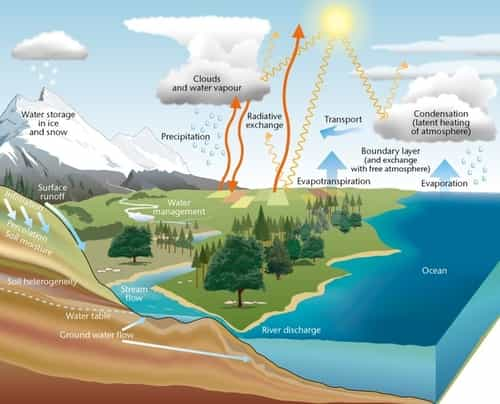70% of the earth's surface is covered with water but still, the world is facing an acute water crisis. This is because, out of total water available on earth, 97.5% is saltwater. Of the remaining water, 99% is locked in glaciers and underground sources. So, technically, less than 1% of fresh water is available for human use in the form of rivers, lakes, streams, etc. please note that this less than 1% water availability is sufficient to fulfil the needs of even the last man on this planet.
But owing to human encroachments at all levels, the existence of mankind will be at risk in the near future if proper precautionary measures for optimum use of water resources are not put in place. For instance, 12% of the Indian population is already at the brunt of the "day zero" scenario.
To tackle this global problem of the water crisis, let us understand the genesis of the water cycle through this article. This article consists of all relevant information required from exam point of view.
Hydrological cycle (Water cycle)
The water cycle is defined as continuous circulation of water from the earth to atmosphere and vice versa which is powered by the energy of the sun. It shows storage and movement of water between biosphere, lithosphere and hydrosphere.

Major Water Sinks
Water can be stored in any of the reservoirs like atmosphere, oceans, lakes, rivers, soils, glaciers, snowfields and groundwater.
Processes involved
- The processes involved in the movement of water from one reservoir to another are-
- Evaporation, condensation, precipitation, deposition, runoff, infiltration, sublimation, transpiration, melting and groundwater flow.
- The driving source of energy for the water cycle is solar radiation or solar energy.
- Evaporation and precipitation are the main processes involved in the water cycle.
- Some of the processes are discussed below:
- Evaporation- Water from the ocean, lakes, ponds, rivers and streams evaporates by the sun’s heat and energy. Water remains in vapor state in air and forms cloud.
- Transpiration- Evaporation through the plant surface due to solar energy is known as transpiration. Plants also transfer a huge amount of water in the atmosphere through transpiration.
- Precipitation- Cloud meets with the cold air in the mountains and above forest regions and condenses to form rain precipitates.
- Condensation- It is the process by which water vapours in the atmosphere gets converted into liquid droplets.
- Runoff: Water discharged from the surface is known as runoff. If it is discharged through rivers, it is known as river runoff.
The ocean supplies most of the evaporated water. On average 84% of water lost from the oceans through evaporations while 77% gained by precipitation. Water from runoff, streams and rivers covers the 7% to balance the evaporation deficit of oceans. On land, evaporation is 16% and precipitation is 23%.
UPPCS 2021: A Foundation Course (Prelims cum Main)
To boost the preparation of all our users, we have come up with some free video (Live Class) series.
Here are the links:
UPPCS 2021 (Pre/Mains) - बनें प्रशासनिक ऑफिसर
राज्य परीक्षाओं के लिए करंट अफेयर्स
UP स्टेट Exams- उत्तर प्रदेश की सभी राज्य-स्तरीय परीक्षाओं के लिए मास्टर सीरीज
उत्तर प्रदेश राज्य परीक्षाओं के लिए 2000 सबसे महत्वपूर्ण प्रश्न
More from us
NCERT Books PDF (Hindi/English)
Get Unlimited access to Structured Live Courses and Mock Tests- Online Classroom Program
Get Unlimited access to 70+ Mock Tests-BYJU'S Exam Prep Test Series



Comments
write a comment